Respect It - Display
It Correctly - Treat It With Care
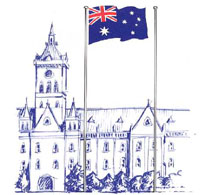 |
It is the universal custom to display
the national flag from sunrise to sunset on buildings and on stationary
flag staffs in the open on all days that weather permits, but especially
on national and state holidays and other days that may be proclaimed by
the Government.
When the Australian National Flag
is flown alone on top of, or in front of a building where there are
two flagpoles, it should be flown on the flagpole to the left of the
observer facing the flag.
|
| When
the Australian National Flag is flown alone on top of, or in front
of, a building where there are more than two flagpoles, it should be
flown as near as possible to the centre. |
- The Australian National Flag
may be
displayed 24 hours a day
if properly illuminated during hours of darkness.
Always hoist the Australian National Flag
briskly. Lower it ceremoniously.
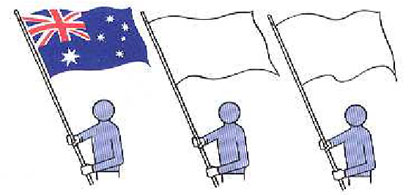 |
- If carried
with other flags, in a single file, the Australian National Flag
should always lead.
|
SALUTING THE FLAG: When a national flag
is raised or lowered as part of a ceremony, or when it passes by in a
parade or in review, all persons, except those in uniform, should face the
flag and stand at attention with (optionally) the right hand over the
heart.
When not in uniform, a man should remove his hat with his
right hand and hold it at the left shoulder, the hand being over the
heart. Those in uniform should give the
military salute. The flag should be saluted at the moment it passes in a parade or
in review. Citizens of other countries stand at attention, but need not
salute.
- When displayed
from a staff
in a church
or public auditorium, the flag of Australia should be in the position of
honour at the clergyman's or speaker's right as he faces the audience (the
left of the audience). Any other flag so displayed is to be placed to the
speaker's left as he faces the audience (the right of the audience).
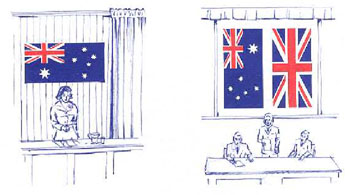 |
If displayed flat against a wall on a
speaker's platform, the Australian National Flag should be placed above
and behind the speaker, with the union on the left hand side as the
audience sees it.
- Note the correct way of hanging
the flag vertically.
|
The Australian National Flag
should be at the
centre
and at the
highest point
of the group when a number
of flags of
States or localities
or pennants of societies are grouped and
displayed from staffs.
When the Australian National Flag is on display with
flags of other nations, all staffs should be of equal height with the Australian National Flag
in the position of honour at the Australian flag's own right, which is the
extreme
left as the flags are viewed.
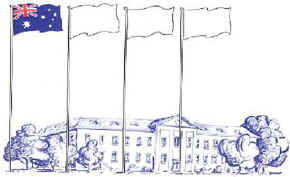 |
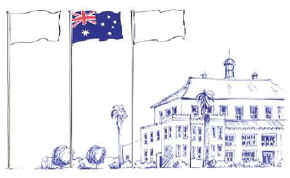 |
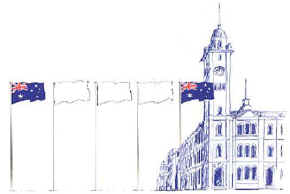 |
When displayed outdoors with
other flags, the position of honour for the Australian National Flag is
normally the extreme left position as the
flags are most frequently viewed, except
in a line of flags representing a
number of sovereign nations, where there are three or more making an
odd number of flags, the Australian National Flag should be flown in
the centre. The Australian National Flag should be flown at BOTH ends if 2 flags are available regardless of overall number of
flags. |
- The Australian National Flag
when displayed with another flag against a wall from crossed staffs, should
be on the
Australian flag's own right,
(left side as seen by audience) and its staff should be in front of the
staff of the other flag.
|
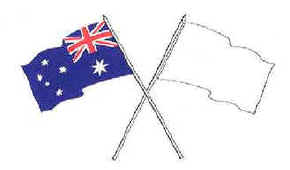 |
When the Australian National Flag
is displayed on a pole projecting from a building, the union of the flag
should be placed
at the peak of the staff
unless the flag is at half staff (half mast).
When suspended from a rope extending from the building on a pole, the flag
should be hoisted out union first from the building.
| When displayed on a
flagpole fitted with a yardarm with a flag of a sovereign nation or a
State flag, the Australian National Flag is displayed as follows: |
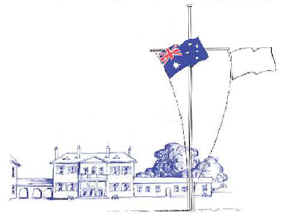 |
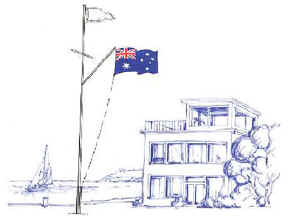 |
- If
the flagpole is fitted with a gaff the flag on the gaff has the
position of honour, although the
national flag is then lower than another flag flying from the peak.
This tradition originated in the days of sailing ships and was
designed to keep the flag from the ship's rigging.
|
When flags of two or more
nations are displayed:
In this circumstance, all the flags including the Australian National Flag
are to be flown from separate staffs of the same height. The flags should be
of approximately equal size.
International usage forbids the display of one
nation's flag above that of another nation's in time of peace.
When other flags are flown from adjacent staffs, the Australian National Flag
should be hoisted first and lowered last. No flag may fly above or to the
right of the Australian flag.
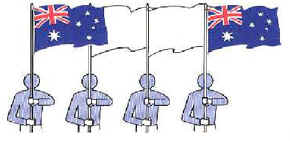 |
- If carried in line
abreast, it is preferable to have the Australian National Flag at each
end of the line.
|
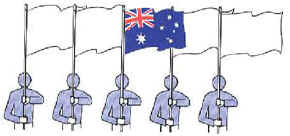 |
- If only one Australian
National Flag is available, it should be placed in the centre of the
line of flags carried abreast in a line made up of an uneven
number of flags.
|
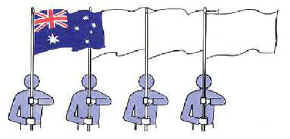 |
-
Where the number of flags is
even
and the Australian National Flag
cannot be carried in the centre (of a line of flags abreast) it should
be placed (carried) on the right-hand end of the line facing the
direction of movement.
|
- When suspended vertically
in the middle of a street the top left quarter should face the north
in an east-west street, and face east in a north-south street, thus
being on the left of the observer facing east or south respectively.
|
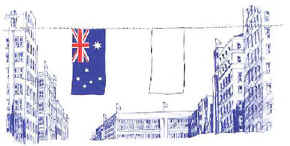 |
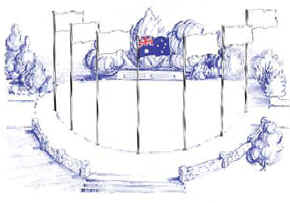 |
- In a
semi-circle of flags representing a number of sovereign nations, the
Australian Flag should be in the centre.
|
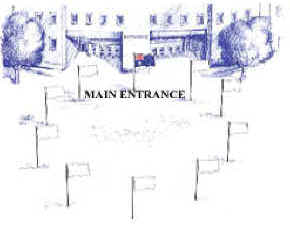 |
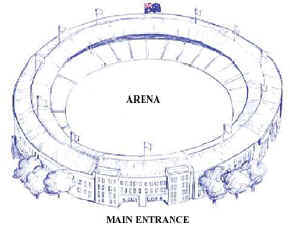 |
- In an
enclosed circle of flags representing a number of sovereign nations,
the Australian National Flag should be flown on the flagpole
immediately opposite the main entrance to a building or arena.
|
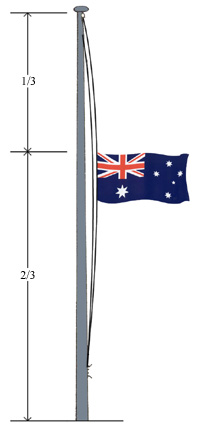 |
When flown at half staff (half mast),
the Australian National Flag should be
first hoisted to the peak for a
moment and then lowered to the half staff
(half mast) position.
The flag
should
be again raised to the peak before it is lowered for the day.
|
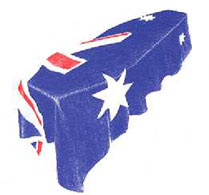
|
| When the Australian National Flag
is used to cover a casket, it should be so placed that the union is at the
head and over the left shoulder.
The flag should not be lowered into the
grave or allowed to touch the ground. |
|
| The
custom of flying a flag at half-mast (half-staff) arose from the flag
being lowered the distance of a flag to allow
"the invisible flag of
death" to
be flown above it. This means if the flag is 1.5 metres
deep and the rope at the bottom as about the same length, then the
flag would be lowered 3 to 3.5 metres - not half way down the pole.
A concerned reader; 30 March 2003
Webmasters note. The
Concerned Reader is correct under older guidelines but the current accepted
correct position is as described in the diagram above, namely 1 third
down the pole as measured at the top of the flag. |
IMPORTANT DON'Ts
It is generally not desirable
to fly the flag outdoors when the weather is particularly inclement because
exposure to severe winds and rain may damage the flag or pole on which it is
displayed.
Never in any way should
disrespect be shown the Australian National Flag.
-
The Australian National Flag
should never be dipped to any person or thing with the sole exception of the
Sovereign.
Regimental colours, State
flags, and organization or institutional flags may be dipped as a mark of honour.
The Australian National Flag
should never be displayed with the Union down except as a signal of dire
distress in instances of extreme danger to life or property.
The Australian National Flag
should never touch anything beneath it
- ground, floor, water, or
merchandise. When the flag is lowered, no part of it should touch the ground
or any other object; it should be received by waiting hands and arms. To
store the flag it should be folded neatly and ceremoniously.
The Australian National Flag
should
never be carried horizontally, but it should always be aloft and
free.
-
Always allow the Australian National Flag
to fall free - never use the Australian National Flag as wearing apparel,
bedding or drapery, festooned, drawn back, nor up in folds.
The Australian National Flag
should never be fastened, displayed, used, or stored in a manner which will
permit it to be easily torn, soiled or damaged in any way.
Never use the Australian National Flag
as a covering or drape for a ceiling.
The Australian National Flag
should never have placed upon it, or on any part of it, or attached to it,
any mark, insignia, letter, word, figure, design, picture or drawing of any
nature.
Never use the Australian National Flag
for receiving, holding, carrying or delivering anything.
-
The Australian National Flag
should not be embroidered on such articles as cushions, handkerchiefs and
the like, printed or otherwise impressed on paper napkins or boxes or
anything that is designed for temporary use or discard.
Advertising signs
should not be fastened to a staff or halyard from which the flag is flown.
Never use any part of the Australian National Flag
as a costume or athletic uniform. A flag patch may be affixed to uniforms of
military personnel, firemen, policemen and members of patriotic
organizations.
Never display the Australian National Flag
from a float except from a staff, or so suspended that its folds fall free
as though staffed.
The flag should be cleaned
and mended when necessary.
-
When the Australian National Flag
is in such condition that it is no longer a fitting emblem for display, it
should be destroyed in a dignified way, preferably by burning, privately.
Official Dates on which the Flag
should be flown
| January 1 |
Anniversary of the establishment of
the Commonwealth of Australia |
| January 26 |
Australia Day (and on the public
holiday observed by each individual state and territory) |
| February 6 |
Anniversary of the accession of the
Sovereign |
| April 21 |
Anniversary of the birthday of the
Sovereign |
| April 25 |
Anzac Day (flown at half-mast until
midday, then masthead until sunset) |
| May 9 |
Anniversary of the inauguration of
Canberra as the Seat of Government of the Commonwealth (Canberra
only) |
| June 2 |
Anniversary of the Coronation of
the Sovereign |
| June 10 |
Birthday of the Consort of the
Sovereign |
| June... |
Official Birthday of the Sovereign
and Commonwealth Day (actual date of the Queen's Official Birthday
proclaimed annually) |
| October 24 |
United Nations Day |
| November 11 |
Remembrance Day (flown at the peak
from 8am to 10:30 am; half mast until 11:03am; at the peak for the
remainder of the day) |
| November 14 |
Birthday of the Heir Apparent |
|
Images from The Army Ceremonial
Manual and/or Australian Government Publishing Service.
|
|